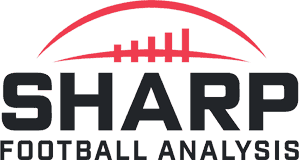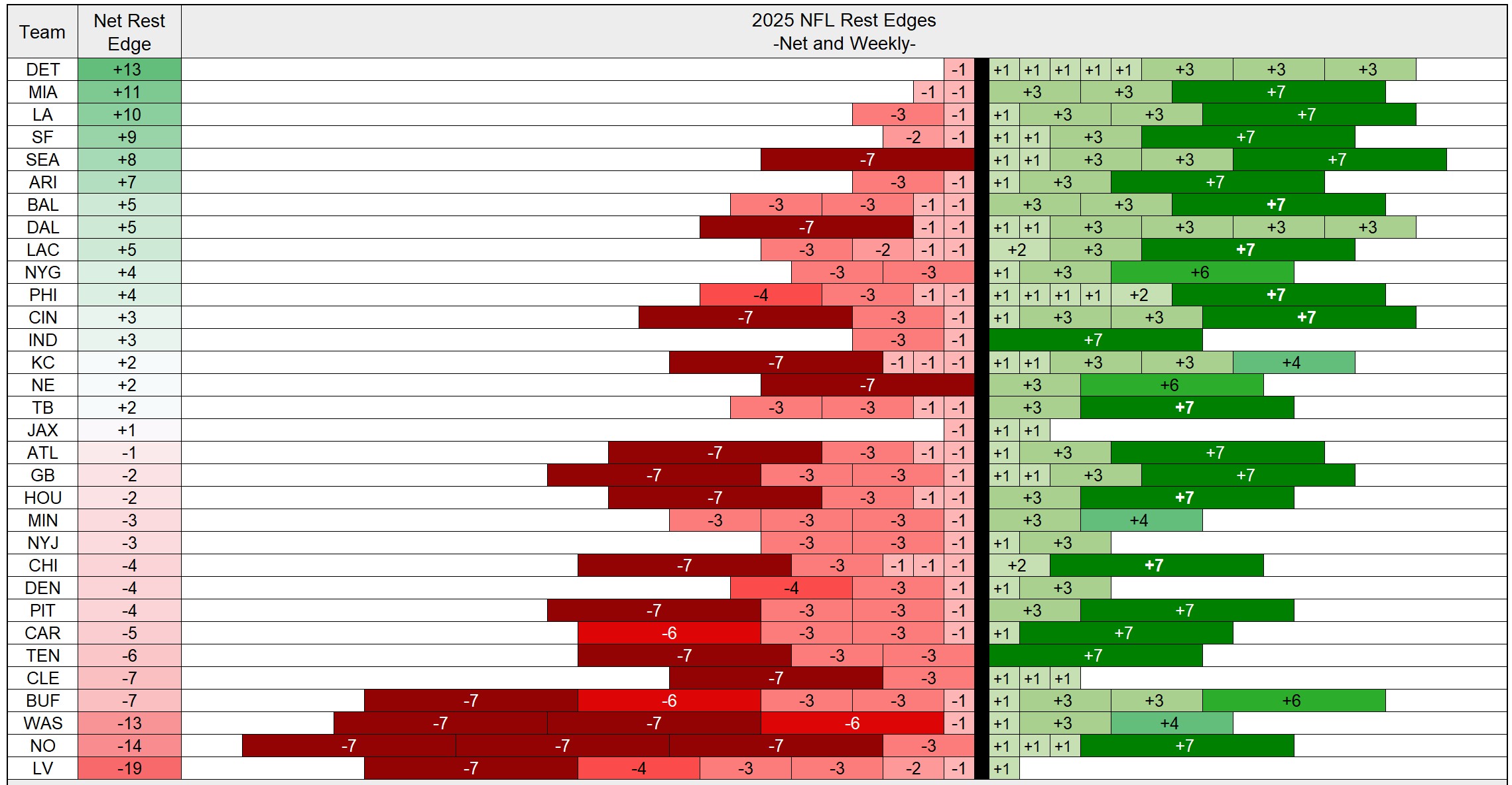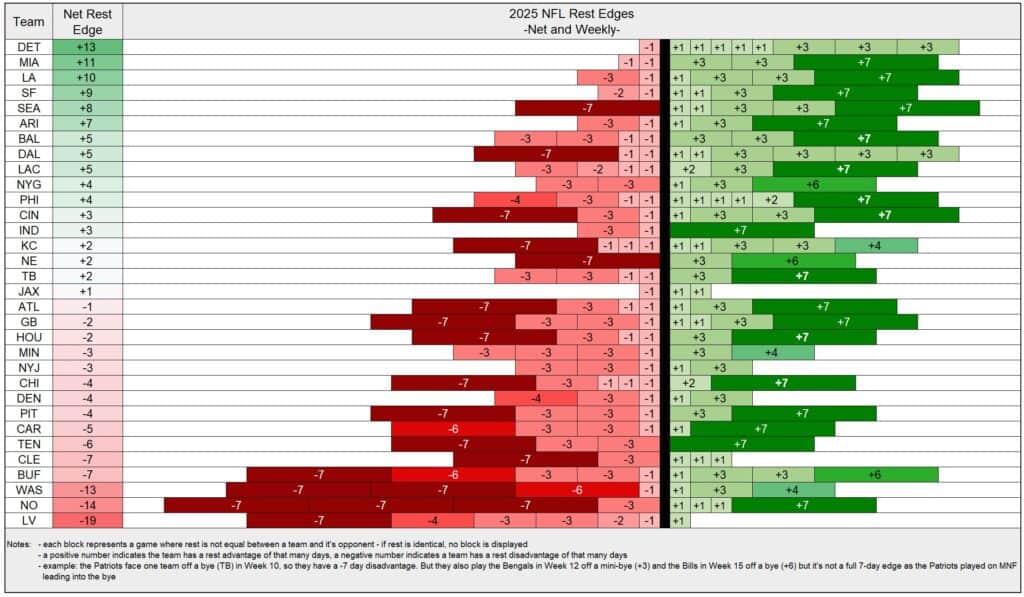- The Lions have the #1 largest net rest edge (+13 days) in the 2025 NFL season
- The Raiders have the #1 largest net rest disadvantage (-19 days) in the 2025 NFL season
- The 2025 NFL schedule features a 32-day swing in rest edge between best (+13) and worst (-19)
After reviewing last year’s 2024 schedule, I was very concerned.
I noted in my in-depth analysis:
“The NFL released the 2024 schedule, and it is a major cause for concern on several fronts.
It is particularly concerning because the NFL has been getting worse at trying to make the schedule fair and equitable over the last several years.
This spills all the way to player safety, as the NFL continues to prioritize key matchups and big-time games for TV revenue over giving teams balance in the timing of their games while protecting player health.
Scheduling inequality is trending in the wrong direction: 2023’s schedule notably put less emphasis on trying to deliver an equitable schedule related to rest and prep factors than did the 2021 or 2022 schedule, and 2024’s schedule was even worse.”
While there are some exceptions that I will dig into momentarily, I am pleased to share that, in sum, the 2025 NFL schedule did not continue the trend of making things less equitable.
The 2024 NFL schedule represented the all-time worst marks in several areas, and the 2025 NFL schedule, in most instances, adjusted to reduce these inequalities.
In summary, when it comes to this year’s schedule compared to prior iterations, there were more improvements made than problems added, which I couldn’t say at this time last year.
However, there is still work to be done to make the schedule more equitable.
For example:
- Last year, the #1 largest net rest edge was +16 days (Ravens), which was the largest in NFL history.
- This year, the #1 largest net rest edge is +13 days (Lions).
While an improvement compared to 2024, it still ranks as the #5 largest net rest edge of the last 25 years (since 2000).
- Last year, the #1 largest net rest disadvantage was -21 days (49ers), which was the #1 largest in the prior decade and the #6 largest since 1990.
- This year, the #1 largest net rest disadvantage is -19 days (Raiders).
While an improvement, it still ranks as the #9 largest of the last 25 years (since 2000).
- Last year, there was a 37-day swing in rest edge between the best (+16) and worst (-21) teams, the #1 largest delta for any NFL season since 2000.
- This year, the delta is 32 days.
While an improvement, it still ranks as the #7 largest delta of the last 25 years (since 2000).
- Last year, there were 66 games played where one team had 3+ days of rest advantage, the most in NFL history.
- This year, there are 61 such games.
While an improvement, 61 games ranks as the #4 most in NFL history.
- Last year, there were 101 games played out of 272 (37%) where one team had a rest advantage over their opponent, the most in NFL history.
- This year, there are still an identical 101 games being played out of 272 (37%) where one team has a rest advantage over their opponent, tied for the most in NFL history.
Why is it important to check for these issues (and others) to ensure the schedule is as fair as possible?
For two key reasons:
- By nature, with only 17 games per team, the NFL schedule is the least “equitable” to all 32 teams of any major American professional sports league.
- The NFL does not prioritize making the schedule equitable.
Let’s expand on each reason.
Preorder The Best Analytical 2025 Football Preview
Don't miss out on Warren Sharp's 500+ page preview of the 2025 NFL season.
The preview is unlike anything you have ever seen, featuring stunning visualizations built with the reader in mind.
This preview shares insights into players, coaches, teams, and philosophies with one goal in mind: to get you prepared for the 2025 NFL season by delivering the smartest information in the fastest, most direct way possible.
Preorder the 2025 Football Preview now!
First, compare the NFL season to other professional sports:
- MLB: 30 teams, 162 games played per team
- NBA: 30 teams, 82 games played per team
- NHL: 32 teams, 82 games played per team
- NFL: 32 teams, 17 games played per team
More teams than most leagues, but substantially fewer games.
As a result of such few games, the strength of schedule between NFL teams skews massively each season between the easiest and toughest.
This year, for example:
- The New York Giants play 11 games against teams expected to have a winning record this season. They play five games against teams with 14+ wins last year and nine games against teams with 11+ wins last year.
- The New England Patriots play five games against teams expected to have a winning record this season. They play zero games against teams with 14+ wins last year and three games against teams with 11+ wins last year.
Theoretically, these two teams are expected to have an even chance to compete for the Super Bowl this year, but the schedule of opponents they face makes it extremely likely that there will be nothing “even” about their likelihood of winning a Super Bowl.
The path through the 2025 schedule for the Giants is orders of magnitude more difficult.
There aren’t enough games played to distribute all the opponents evenly (think 31 games played each year, one against every other team in the NFL).
More than any other professional league, WHO you play matters more in the NFL, and the schedules are not going to be balanced.
As a result, if we know the opponents each team plays are not going to be balanced, the least the NFL could do is to try and keep the looks that they are trying to spread out the disadvantages from a game timing perspective as evenly as possible around the NFL.
Teams don’t want to play on short rest.
Teams don’t want to play opponents who have more rest than they do.
Considering all teams feel the same in this regard, the NFL might think to prioritize its schedule to balance the inequalities that inevitably will present themselves when you’re trying to schedule 272 games throughout a four-month season.
Which leads us to the second point.
The NFL does not prioritize making the schedule equitable.
There are guardrails to ensure the schedule they choose does not get too biased for their liking, but making a fair schedule is not a top priority, and who is to say the NFL’s opinion of what is “acceptable unfairness” is appropriate?
If this surprises you, you need to hear from the NFL’s VP of Broadcast Planning, Mike North, who said this about the schedule:
“You’ve got these 272 games and they are their assets… they are all worth a little something different. So we want to make sure that the ones that are worth the most are available to as many fans as possible.
Put them in national television windows get maximum value out of them.
We’re trying to drive engagement, drive viewership and obviously it’s a business, so drive revenue”
The NFL has made it clear that increasing viewership to increase ratings to land more lucrative media rights deals in the future is the #1 priority, and North has said similar for a few years now.
When asked on the Ross Tucker Show why the team decided to put the Chiefs against the Cowboys on Thanksgiving, when the Cowboys game on Thanksgiving is already one of the most watched NFL games every year, North said they wanted to go as big as possible.
“Maybe we can get Taylor (Swift) to sing the National Anthem to get people involved beyond avid football fans. Let’s see if we can set a record that day. Let’s push for 48, 49, 50 million.”
This is their prime focus. It’s setting records for viewership to get more lucrative media deals in the future.
Period. End of story.
North also added about the guardrails analogy I mentioned before:
“There’s a line that we shouldn’t cross when it comes to things like competitive fairness and player health and safety, travel, whatever it is. Push the engagement, push the viewership, and maybe walk right up to that competitive inequities line, but don’t cross over it.”
North and his team know there is a give and take.
They could make a perfectly fair schedule from a rest and prep perspective, but the schedule may not have as many great teams playing in prime time in a given week.
So, to place those “assets” where they are most likely to create spikes in viewership and ratings, the byproduct will be an increase in inequality.
The NFL would rather not discuss that.
They would rather no one checks their work, like I do each year.
They would rather answer privately to a few teams, play the games, and for no one to question how much intentional inequality exists in their schedule and how much is too much.
But for years, that’s what I’ve done.
I’ll share the positive and the negative in hopes that the NFL produces future schedules that give as many teams as even a shot at the Super Bowl as possible each season.
So let’s begin the process of walking through the 2025 NFL schedule and evaluating the work the NFL did.
In doing so, we will answer the following questions for all 272 games:
- Is a team at a rest disadvantage in a game compared to their opponent?
- How many days do they have to prepare for their game?
- How many does their opponent have?
- Are they coming off a road game on a short week?
- Is their bye week edge negated?
To evaluate the aspect of NFL strength of schedule that deals with the timing of the games, we need to look at several variables related to rest and prep, including:
- Net rest edges
- More or less rest than the opponent
- Opponent’s days to prepare for the game
- Short week road games
- Off road games on Sunday night or Monday night
- Negated bye weeks
- Three Games in 10 Days
- Four Games in 17 Days
NFL Rest Edge & Disparity in the 2025 Schedule:
What is a rest edge in the NFL?
A rest edge in the NFL is the number of extra days a team has to rest and prepare for their game over their opponent.
An example of rest edge: if the Dolphins have a full 7-day bye week ahead of their game vs the Bills, and the Bills play on Monday Night Football and are on a short week, the Dolphins have a rest edge of +8 days before their game against the Bills. Conversely, the Bills have a rest edge of -8 days.
What is net rest in the NFL?
Net rest is the cumulative sum of individual game rest edges throughout an entire NFL season.
An example of net rest: the Patriots face one team off a bye (TB) in Week 10, so they have a -7 day disadvantage that week. But they also play the Bengals in Week 12 off a mini-bye (+3) and the Bills in Week 15 off a bye (+6). That bye is not a full 7-day edge as the Patriots played on Monday Night Football leading into the bye. As a result, the Patriots' net rest edge for the 2025 season is +2 days (-7+3+6).
As we've seen with previous seasons, rest edges can be a massive benefit to one team or the other.
It’s not always the total nest rest that matters.
It can also be individual games with a rest advantage that matters.
Having a rest edge does not mean you’re easily going to win a game, nor does a rest disadvantage mean you’re going to lose.
But it’s a factor, and it matters to teams. Particularly when we’re talking about a 3+ day rest edge (more on measuring rest edges to follow).
The graphic below shows the net rest edge for each team this season.
Each block is a single game where one team has a rest advantage or disadvantage.
For example, a +1 block for Detroit indicates they have 1 extra day of rest compared to their opponent in one game this season.
Sum up the individual game blocks, and you get the net rest edge for the season. A team with just four blocks total means they have “even” rest with their opponent in their other 13 games, thus no edge or deficit.
*Click on image to enlarge and download*
There is a 32-day swing in rest edge between the best (+13) and worst (-19) teams in rest edge.
This ranks as the #7 largest delta of the last 25 years (since 2000).
2025: 32 days ◄
2024: 37 days
2023: 32 days
2022: 24 days
2021: 27 days
2020: 26 days
2019: 24 days
2018: 24 days
Which NFL team has the best rest edge in 2025?
The Detroit Lions have the best rest edge for the 2025 NFL season.
The Lions have 13 more days of rest than their opponents.
This ranks as the #5 largest net rest edge of the last 25 years (since 2000).
Which NFL team has the worst rest edge in 2025?
The Las Vegas Raiders have the worst rest edge for the 2025 NFL season.
The Raiders have 19 fewer days of rest than their opponents.
This ranks as the #9 largest of the last 25 years (since 2000).
More Rest Than Opponent
Since 1990, only six teams total played 6+ games with a rest advantage in a season.
It didn’t happen to a single team last year.
It is happening to three teams this year alone (Lions, Eagles, Cowboys).
Meanwhile, three teams play no more than one game with a rest advantage (Titans, Colts, Raiders).
The Detroit Lions are the most exceptional example of a team playing an incredible amount of games with a rest advantage that we’ve seen in NFL history.
This year, the Lions play eight games with a rest edge over their opponent.
If this sounds like an anomaly, it absolutely is.
No team in NFL history has played more than six games with a rest advantage in a season.
If the Lions played seven such games, they would set the record.
But the Lions have an NFL record eight games with a rest edge over their opponent.
Think about it from this perspective: nearly HALF of the Lions' 2025 games have them playing at a rest advantage.
Meanwhile, three teams play just one game all season with a rest advantage.
Let’s look at the Lions' rest edges:
Week 2: Lions play the Bears, who are off a Week 1 MNF game (+1 Lions)
Week 5: Lions play the Bengals, who are off a Week 4 MNF game (+1 Lions)
Week 6: Lions play the Chiefs, who are off a Week 5 MNF game (+1 Lions)
Week 9: Lions, off a bye week, play the Vikings, who are not off a bye week (+3 Lions)
Week 11: Lions play the Eagles, who are off a Week 10 MNF game (+1 Lions)
Week 15: Lions, off a mini-bye, play the LA Rams, who are not off a mini-bye (+3 Lions)
Week 16: Lions play the Steelers, who are off a Week 15 MNF game (+1 Lions)
Week 18: Lions, off a mini-bye, play the Bears, who are not off a mini-bye (+3 Lions)
The Lions are the first team in NFL history to play five opponents off a Monday Night Football game who then must play on a short week with one less day of rest.
In the prior two seasons combined, the Lions played eight total games with a rest advantage over their opponent.
In those two prior seasons, the Lions are 6-2 SU and 6-2 ATS (43% ROI) when playing with a rest advantage.
Detroit’s win rate (75%) with a rest edge is the #5 best in the NFL, and their cover rate (75%) is the #3 best.
Additionally, the Lions play just one game all season with a rest disadvantage, and it is just a one-day disadvantage.
As a result, the Lions are playing +7 net games with a rest edge (8 positive, 1 negative).
No team since at least 1990 has played more than +4 net games with a rest advantage.
The Detroit Lions are likely the first team in NFL history to play +7 net games with a rest edge.
The odd thing about the Lions having all these small edges of playing teams off MNF games is that we know the NFL prioritizes certain teams due to success and likelihood of producing ratings, and thus, certain successful or popular teams might play in a lot of prime time games.
But the Lions are not the team playing in these games.
The Lions are the beneficiary of the Bears, Bengals, Chiefs, Steelers, and Eagles playing in prime time on Monday night and thus facing Detroit the following week on short rest.
It also just so happens that the Lions have key rest edges in three of their four toughest games they will play this year, against the Chiefs, Eagles, and Bengals.
Why Rest Edges Matter in the NFL:
Before we dig into what rest matters, let’s first discuss what rest does NOT matter as much. Surprisingly, it’s the most original form of rest the NFL handed out decades ago: the bye week.
Do Bye Weeks Still Matter?
The simple answer is NFL bye weeks do not provide nearly the benefit they once did.
In 2011, the NFL and the Players Association signed a new Collective Bargaining Agreement (CBA).
Before this CBA, teams were able to practice as often as they wanted during the team’s bye week.
Some coaches gave their players a week off. Other coaches gave their players just a couple of days off and came back to practice much earlier.
But the 2011 CBA put an end to the arbitrary nature of the bye week and guaranteed players would receive four days off.
From division realignment in 2002 to 2010, teams after a bye week won 55.7% of their games as an average half-point favorite and covered the spread in 56.3% of games (7.6% ROI).
But since the 2011 CBA, teams after a bye week have won just 52.3% of their games as an average half-point favorite and covered the spread in 48.6% of games (-7.2% ROI).
In part due to bettors attempting to “chase” the value of teams off bye weeks, the point spreads of teams off bye weeks have increased, and performance has decreased in more recent years.
Since 2017: average favorite of -0.7 points, 46.0% ATS (-12.2% ROI)
Since 2021: average favorite of -1.1 points, 45.6% ATS (-12.9% ROI)
Indeed, with the new CBA, bye weeks are less valuable with the forced time off.
But with every single team receiving a bye week, there is no inequality to be argued.
What Rest Advantages Provide an Edge?
While bye weeks no longer offer an edge, there are rest spots that provide advantages for teams both straight up and against the spread over the last decade.



















